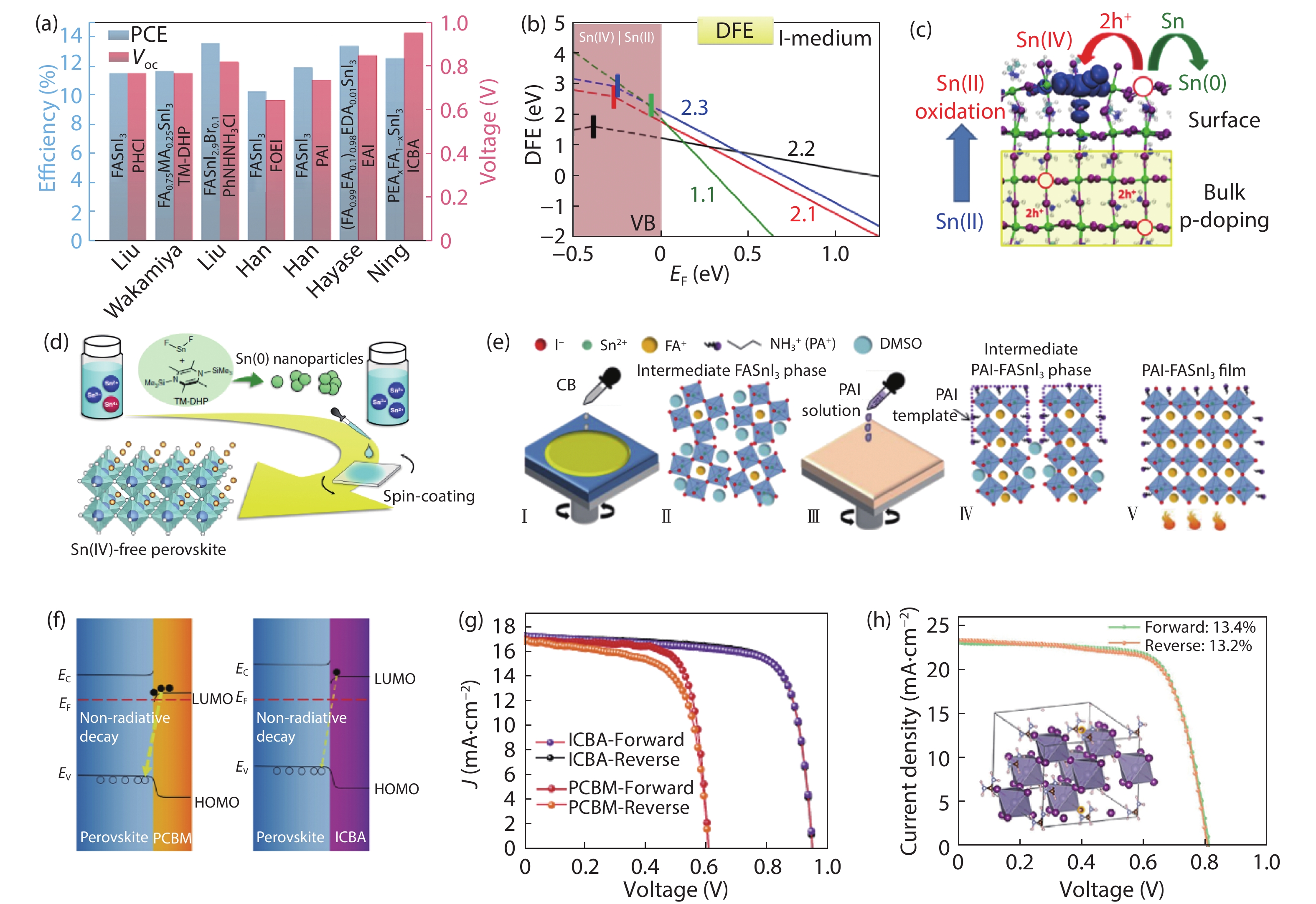| Citation: |
Shurong Wang, Aili Wang, Feng Hao, Liming Ding. Renaissance of tin halide perovskite solar cells[J]. Journal of Semiconductors, 2021, 42(3): 030201. doi: 10.1088/1674-4926/42/3/030201
****
S R Wang, A L Wang, F Hao, L M Ding, Renaissance of tin halide perovskite solar cells[J]. J. Semicond., 2021, 42(3): 030201. doi: 10.1088/1674-4926/42/3/030201.
|
Renaissance of tin halide perovskite solar cells
DOI: 10.1088/1674-4926/42/3/030201
More Information
-
References
[1] Best Research-Cell Efficiencies. https://www.nrel.gov/pv/cell-efficiency.html (accessed Dec. 2020)[2] Hao F, Stoumpos C C, Cao D H, et al. Lead-free solid-state organic–inorganic halide perovskite solar cells. Nat Photonics, 2014, 8, 489 doi: 10.1038/nphoton.2014.82[3] Hao F, Stoumpos C C, Guo P, et al. Solvent-mediated crystallization of CH3NH3SnI3 films for heterojunction depleted perovskite solar cells. J Am Chem Soc, 2015, 137, 11445 doi: 10.1021/jacs.5b06658[4] Tong J, Song Z, Kim D H, et al. Carrier lifetimes of > 1 μs in Sn-Pb perovskites enable efficient all-perovskite tandem solar cells. Science, 2019, 364, 475 doi: 10.1126/science.aav7911[5] Gupta S, Cahen D, Hodes G. How SnF2 impacts the material properties of lead-free tin perovskites. J Phys Chem C, 2018, 122, 13926 doi: 10.1021/acs.jpcc.8b01045[6] Ricciarelli D, Meggiolaro D, Ambrosio F, et al. Instability of tin iodide perovskites: bulk p-doping versus surface tin oxidation. ACS Energy Lett, 2020, 5, 2787 doi: 10.1021/acsenergylett.0c01174[7] Li W, Li J, Li J, et al. Addictive-assisted construction of all-inorganic CsSnIBr2 mesoscopic perovskite solar cells with superior thermal stability up to 473 K. J Mater Chem A, 2016, 4, 17104 doi: 10.1039/C6TA08332C[8] Nakamura T, Yakumaru S, Truong M A, et al. Sn(IV)-free tin perovskite films realized by in situ Sn(0) nanoparticle treatment of the precursor solution. Nat Commun, 2020, 11, 3008 doi: 10.1038/s41467-020-16726-3[9] Song T B, Yokoyama T, Stoumpos C C, et al. Importance of reducing vapor atmosphere in the fabrication of tin-based perovskite solar cells. J Am Chem Soc, 2017, 2, 836 doi: 10.1021/jacs.6b10734[10] Wang C, Gu F, Zhao Z, et al. Self-repairing tin-based perovskite solar cells with a breakthrough efficiency over 11%. Adv Mater, 2020, 32, 1907623 doi: 10.1002/adma.201907623[11] Wang C, Zhang Y, Gu F, et al. Illumination durability and high-efficiency Sn-based perovskite solar cell under coordinated control of phenylhydrazine and halogen ions. Matter, 2021, 4, 709 doi: 10.1016/j.matt.2020.11.012[12] Meng X, Wang Y, Lin J, et al. Surface-controlled oriented growth of FASnI3 crystals for efficient lead-free perovskite solar cells. Joule, 2020, 4, 902 doi: 10.1016/j.joule.2020.03.007[13] Jiang X, Wang F, Wei Q, et al. Ultra-high open-circuit voltage of tin perovskite solar cells via an electron transporting layer design. Nat Commun, 2020, 11, 1245 doi: 10.1038/s41467-020-15078-2[14] Liu X, Wu T, Chen J, et al. Templated growth of FASnI3 crystals for efficient tin perovskite solar cells. Energy Environ Sci, 2020, 13, 2896 doi: 10.1039/D0EE01845G[15] Jokar E, Chien C H, Tsai C M, et al. Robust tin-based perovskite solar cells with hybrid organic cations to attain efficiency approaching 10%. Adv Mater, 2019, 31, 1804835 doi: 10.1002/adma.201804835[16] Jokar E, Chien C H, Fathi A, et al. Slow surface passivation and crystal relaxation with additives to improve device performance and durability for tin-based perovskite solar cells. Energy Environ Sci, 2018, 11, 2353 doi: 10.1039/C8EE00956B[17] Nishimura K, Hirotani D, Kamarudin M A, et al. Relationship between lattice strain and efficiency for Sn-perovskite solar cells. ACS Appl Mater Interfaces, 2019, 11, 31105 doi: 10.1021/acsami.9b09564[18] Liu X, Wang Y, Wu T, et al. Efficient and stable tin perovskite solar cells enabled by amorphous-polycrystalline structure. Nat Commun, 2020, 11, 2678 doi: 10.1038/s41467-020-16561-6[19] Ji L, Liu D, Wang Y, et al. Large organic cation incorporation induces vertical orientation growth of Sn-based perovskites for high efficiency solar cells. Chem Eng J, 2020, 402, 125133 doi: 10.1016/j.cej.2020.125133[20] Shao S, Dong J, Duim H, et al. Enhancing the crystallinity and perfecting the orientation of formamidinium tin iodide for highly efficient Sn-based perovskite solar cells. Nano Energy, 2019, 60, 810 doi: 10.1016/j.nanoen.2019.04.040[21] Nishimura K, Kamarudin M A, Hirotani D, et al. Lead-free tin-halide perovskite solar cells with 13% efficiency. Nano Energy, 2020, 74, 104858 doi: 10.1016/j.nanoen.2020.104858[22] Basera P, Kumar M, Saini S, et al. Reducing lead toxicity in the methylammonium lead halide MAPbI3: Why Sn substitution should be preferred to Pb vacancy for optimum solar cell efficiency. Phys Rev B, 2020, 101, 054108 doi: 10.1103/PhysRevB.101.054108 -
Proportional views






 DownLoad:
DownLoad:














